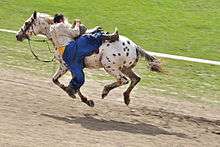Jigit

Djigit, in some turkic languages also spelled as yigit or zhigit, is a word of Turkic origin[1] which is used in the Caucasus and Central Asia to describe a skillful and brave equestrian,[2] or a brave person in general.
The derived term jigitovka (or jigiting) means the special style of trick riding, which originated in the turkic cultures of Caucasus and Central Asia, and is also popular with Russian Cossacks, who adopted it from the people of Caucasus.[3] When performing dzhigitovka, the riders at full gallop stand up, jump to the ground and back to the saddle, pick up objects from the ground (such as coins, hats, etc.), shoot targets with various weapons, ride hanging on the side or under the belly of the horse and do other acrobatic feats.[1]
Since the early 19th century jigitovka has been demonstrated in the circuses and horse sport competitions, and made its way to the popular Western culture, for instance Russian Cossacks (actually Georgian horsemen from western part of Georgia, Guria) demonstrated jigitovka as part of Buffalo Bill's Wild West Show.[4] Jigitovka was also used in training of cavalry forces in the Russian Empire and USSR.
Jigitovka as a sport competition is performed on a horse galloping at the 360 m long and 10 m wide path. The exercises are divided into three groups by their complexity. Maximum points are given for exercises of the most complex third group. Jigitovka as a circus performance includes complex stunts usually performed by a group of riders.
References
External links
- History and current status of dzhigitovka - rus.
- Russia dzhigitovka
- Horse Training. History, training dzhigitovka Russia
- Georgian Trick Riders in American Wild West Shows, 1890s-1920s by Irakli Makharadze, Publisher: McFarland